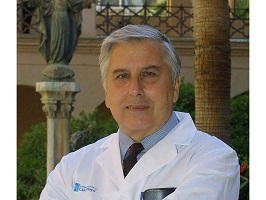Keynote Forum

Henryk Kalisz
University of Manchester, UKTitle: Accelerated molecular dynamics simulation, functional sequence space clustering and experimentally guided machine learning as an integrated tool for the customization of enzyme performance for defined industrial applications
Abstract:
Enzymes play an important role in a wide range of industries, such as food and feed, agriculture, personal care, textiles, laundry detergents, fine chemicals, and pharmaceuticals. Some examples where enzymes are crucial include cheese manufacture, beer and winemaking, baking bread, fruit juice extraction and clarification, leather tanning and more recently in the production of biofuels and biopolymers1,2. Further, due to their high enantio- and regio-selectivity, leading to higher yields of the required enantiomer, enzymes are increasingly used in fine chemical synthesis and in the production of chiral pharmaceutical intermediates and APIs.
The enzymes used for various industrial applications can be harvested from microbial sources or they can be customized for a defined industrial application and overexpressed in heterologous hosts such as bacteria, yeasts and filamentous fungi. This type of enzyme engineering is a powerful way to obtain large amounts of a customized enzyme to replace traditional chemical processes3.
The enormous progress made in recent years in this area is based on new approaches for the screening and identification of novel enzymes, on the development of various protein engineering methods to tailor enzymes with the defined or novel properties, and on the availability of sequence and structural data on a wide range of enzymes that give rise to powerful new machine learning approaches. One recently developed technology making an important contribution to the discovery of novel proteins and engineering of customised enzymes for defined industrial applications involves the application of a proprietary enzyme design platform overcoming key efficiency bottlenecks in statistical structure-dynamics analysis4 and enabling the streamlined functional clustering of protein sequence space. This powerful technique allows the fast and reliable identification and subsequent engineering of hotspots in a protein, resulting in a rapid and inexpensive improvement of enzyme properties, such as chirality, catalytic activity, stability, substrate specificity, stereoselectivity. Further, this technology can apply a function to sequences during enzyme discovery, thereby enabling the identification of protein homologues with potentially better properties than the target enzyme and provides outstanding opportunities for the selection and subsequent design of industrial enzymes with the desired properties. This presentation seeks to provide a description of this enzyme design technology in the discovery and design of customized enzymes.
Biography:
Henryk Kalisz obtained his Ph.D. in Biochemistry at Manchester University, has published over 60 papers in reputed scientific journals. He has over 30 years of experience in industrial enzymology and biotechnology. After his Ph.D., he worked as a postdoctorate at the University of Freiburg, Freiburg, Germany, before taking up a senior scientist role at the National Research Institute (Gesellschaft für Biotechnologische Forschung) in Braunschweig, Germany. He subsequently worked as Head of Biochemistry at Pharmacia, Nerviano, Italy, and as Chief Scientific Officer at Eucodis Bioscience in Vienna, Austria. Since October 2011 he has been applying his expertise in industrial enzymology as a consultant and independent representative to provide scientific and technological advice and assistance to various Biotechnology and Pharmaceuticals organizations.

Hafiz Zaid Mahmood
Virtual University of Pakistan, PakistanTitle: Descriptive Surveillance of brucellosis in small ruminants of district Jhang, Punjab, Pakistan
Abstract:
Utilization of plant-based medications for treating different diseases and individual health dates to the prehistoric ages. Plants and plant-based medicines are the premises of many advanced pharmaceuticals. In this research, the antibacterial properties of Slender Dwarf Morning – Glory (Evolvulus alsinoides) were assessed. 100 blood samples were collected, and Staphylococcus aureus was isolated and was confirmed by the biochemical tests. Synthetic antibiotic Vancomycin was applied to check the antibacterial activity through MSSA. Molecular characterization was done by conserved sequences (16S rRNA gene) using Staphylococcus aureus subsp. aureus integrated plasmid, pUR3912, strain ST398 primer. Antioxidant activity, Biochemical testing, Phytochemical analysis (“X-ray diffraction (XRD)” and “Scanning electron microscopy (SEM)” were used for better understanding and confirmation of phytochemical compounds extracted from Evolvulus alsinoides. Results showed that Methanolic plant extract has a clear antibacterial effect against Methicillin sensitive Staphylococcus aureus. Antioxidant activity of the methanolic extract was also proved by DPPH antioxidant assay via TLC.
Biography:
Hafiz Zaid Mahmood is a Microbiologist by profession and works with different food industries in the Quality Department in Pakistan. He holds a B.Sc.(Hons) in Microbiology and currently pursuing a Master of Science degree in Molecular Biology at the Department of Molecular Biology, Faculty of Science and Technology, Virtual University of Pakistan. Hafiz Zaid has more than 5 years of working experience and leading in QA/QC Department of different Food and Packaging industries. He has also participated and presented his research in an international workshop on “technological, biochemical, microbiological, sensorial and manufacturing aspects of Groundwater and Mineral water” at the University of Agriculture Faisalabad, 2106. He is Pursuing his career in the food industry and is passionate about working in renowned research institutes.
Speakers

Fariha Altaaf
University of Veterinary and Animal Sciences, PakistanTitle: Seroprevalence of Bluetongue virus originating among camels from southern Punjab, Pakistan
Abstract:
Bluetongue (BT), caused by bluetongue virus (BTV) is a vector-borne disease of small ruminants such as sheep, goat and also persist in camels. Bluetongue (BT) disease has a prospective to spread across borders. In spite of a large number of populations of susceptible animals and borders with BTV endemic countries, scant is known of disease implication and prevalent serotype in southern Punjab province in Pakistan. We escort a cross-sectional study to determine the seroprevalence of bluetongue virus in selected districts of southern Punjab using a competitive enzyme-linked immunosorbent assay (cELISA). Sera (n = 992) were collected from clinically healthy and non-healthy camels originating from the districts of Bahawalpur (n = 30), Dera Ghazi Khan (n = 207), Multan (n = 100), Muzaffargarh (n = 17), Rahim Yar Khan (n = 255), Rajanpur (n = 152), Taunsa (n = 231). At the individual level, the overall prevalence of BTV was 68% (n = 697/992, 95% CI = 33.11- 38.72%). A higher percentage of seroprevalence was seen in district Muzaffargarh 100% (n = 17/17). Odd ratios of seroprevalence for camels were associated with age type (ᵡ² = 139.59, p = .00), body condition (ᵡ² = 40.61, p = .00), breed (ᵡ² = 19.61, p = .00), feeding status (ᵡ² = 7.96, p = 0.19), farming status (ᵡ² = 24.49, p = .00), Education status (ᵡ² = 11.68, p = .00), pregnancy status (ᵡ² = 21.80, p .00). All the risk factors were significant and contribute towards the presence of BT disease. To the best of our knowledge, this study that has been conducted in southern Punjab province and the results of this study designate to instigate intrusion strategies to control the BT disease burden but not only in the area of Pakistan but also in neighboring countries to whom Pakistan share his border India, Iran, Afghanistan.
Biography:
I am Fariha Altaaf young researcher in the field of Microbiology belongs to Pakistan. I have a passion and learn new expertise in evaluation in improving health and wellbeing. I am very passionate and hardworking to create new pathways for improving healthcare. I have done this research and built this model after years of experience in microbiology research, evaluation, teaching, and administration both from hospital and education institutions. The methodology in this research includes competitive ELISA that illustrates, seroprevalence and association of risk factors. It allows for value-pluralism. This research along with this methodology reveals the presence of BT virus that is transmitted from one region to another and still transmitting. I have done research in bacteriology section that was a project work on Streptococcus pneumoniae from Lahore University of Management Sciences (LUMS). I am very hard working and keen on my fieldwork. In my future, I would like to be work as Microbiologist definitely.

Umar Khalid
University of Agriculture Faisalabad, PakistanTitle: Metagenomics and Molecular Typing of Mosquito-borne Flavivirus in the selected districts of Punjab, Pakistan
Abstract:
Mosquitoes are one of the deadliest animals capable of transmitting the various pathogenic diseases to humans as well as animals. The present study was designed to identify the major species of mosquitoes, prevalent in three districts of Punjab representing the three agro-geo climatic zones viz; Multan, Chakwal and Jhang. Mosquitoes were stereoscopically identified followed by RNA extraction and multiplex RT-PCR. After RNA quantification, molecular characterization of the prevalent mosquito-borne viruses was performed through cDNA synthesis, multiplex RT-PCR followed by agarose gel electrophoresis of the PCR products. It was identified that 4334 (40.6%), 2242 (30%), 2040 (31.6%) were females out of total 10675, 7296 and 6450 mosquitoes collected from districts Chakwal, Jhang and Multan, respectively. It was concluded that, Culex species were present in abundance (73.2%) as compared to the Aedes species (26.7%) in the selected study districts. The multiplex PCR detected Dengue virus (DENV -1 and DENV-2), West Nile Virus (WNV), Japanese Encephalitis Virus (JEV) and Saint Louis Encephalitis Virus (SLEV) in the mosquitoes of all the three selected districts; however, the prevalence of mosquito-borne viruses insignificantly varied (P>0.05) among the three districts. In District Chakwal, SLE was found to be most abundant (13.7%, p=0.12) followed in order by WNV (13%, p=0.17), DENV (8.4%, p=0.91) and JEV (7.8%, p=Ref value), respectively. Similarly, in district Jhang, SLE was found to most prevalent (18.9%, p=0.015), followed by WNV (17.5%, p=0.013), JEV (8.1%, p=0.118) and DENV (4%, p= Ref value). However, in district Multan. WNV was found to be in abundance (27.5%, p=0.005) followed in order by SLE (11.5%, p=0.303), DENV (13%, p=0.199) and JEV (5.7%, p= Ref value). This study has provided a better understanding of the prevailing mosquito and mosquito-borne viruses in the study districts which can help to formulate appropriate control measures.
Biography:
Umar Khalid is currently a Ph.D. scholar with Seven years of experience at hand. Excellent clinical and quality control laboratory skills, with commended performance in conducting laboratory assays and resolving complex clinical and instrumental problems. Accurate, reliable, diligent and focused on the timely, quality completion of all lab procedures. Work well under pressure and time constraints within high-volume environments. Always seeking challenging opportunities to demonstrate my skills and abilities and attain experience and more and more knowledge.

Andrea Borns
Barry University, USATitle: Bringing phage biology out-of-the shadow and into the bedside: when will modern medicine use this ally virus in the battle against superbugs
Abstract:
According to the World Health Organization (WHO), antimicrobial resistance (AMR) is a global crisis that threatens a century of progress in medicine, with alarming levels of resistance being reported by countries of all income levels. The spread of AMR organisms results in common diseases becoming untreatable, and lifesaving medical procedures riskier to perform. Healthcare-acquired infections (HAIs) carry the highest-burden compared to all other infectious diseases including HIV, tuberculosis, and influenza. The Centers for Disease Control and Prevention (CDC) reports that more than 2.8 million antibiotic-resistant infections occur in the U.S. each year, and more than 35,000 people die as a result of it. Although bacteriophage (‘phage’) therapy was discovered about a century ago, the advancement of antibiotics left this forgotten cure to be well-studied only behind the “iron curtains” of the former Soviet Union. The George Eliava Institute physicians have been treating Georgians and patients from other countries successfully for decades. Even though AMR bacterial infections are of great concern globally, it wasn’t until 2016 that the first American patient received intravenous phage therapy in American soil. After approved for an emergency investigational new drug (eIND) by the U.S. Food and Drug Administration (FDA), doctors from the University of California San Diego (UCSD) were allowed to inject trillions of live viruses (‘phage’) in a comatose patient who suffered from pancreatitis caused by one of the worst “superbugs”: Acinetobacter baumannii. Facing life-threatening sepsis, breathing with the help of a ventilator, this patient started to go into multiple organ failure. His multidrug-resistant bacteria was not responding to any antibiotic including colistin until his life-saving phage therapy infusion. Since then, this “alternative cure” is getting more attention and other successful compassionate-use cases in the U.S. followed, opening the doors for phage therapy again. Recently, the U.S. started its first clinical trials using phage therapy to treat AMR urinary tract infection caused by E. coli. Phage therapy has demonstrated its potential use in combination with antibiotics, eliciting the mechanism of synergy, allowing antibiotics to work again. Phage therapy allows for personalized medicine and specifically targets the microorganism causing the infection, leaving the good microbiome untouched. In times of this in which we live amidst the biggest pandemic of human history, it is important to look at evolutionary biology and how “mother-nature” controls its biosphere. These phages are not only efficient in treating bacterial infections, but it can be used to address the use of antibiotics in livestock and pesticides in agriculture. Phage biology is an understudied tool that allows for the development of rapid-test diagnosis, recombination, cloning, development of vaccine platform, environmental bioremediation, phage-based gene therapy among other possibilities in humans, and veterinarian medicine.
Biography:
Andrea Borns, microbiologist and respiratory therapist who holds a Master’s of Public Health is the founder and Chief Executive Officer of ZEN Clinical & Bioscience. ZEN is a newly-formed consulting and laboratory client-driven research and development (R&D) company in the field of bacteriophage therapy and phage biotechnology to address emerging infectious and neglected tropical diseases. Originally from Brazil, Andrea started her career in Biomedical Sciences and was involved in HIV/AIDS research during the late ’90s in Rio de Janeiro. She is also a former Assistant Professor and Director of Clinical Education at the University of the District of Columbia, USA, where she worked closely with lung diseases, critical care, and mechanical ventilation before her comeback to the bench. Working on the bedside managing and treating cystic fibrosis and ventilator-associated pneumonia patients who lost their lives to superbugs, inspire her to leave Academia and the hospital environment to work in basic science. Andrea worked as a microbiologist at American Type Culture Collection (ATCC) and the Biodefense & Emerging Infection Resource (BEI), and as a research technician at the Walter Reed Army Institute of Research (WRAIR). Passionate about basic science, Andrea is interested in bringing the knowledge of phage biology from the bench to the bedside so it can benefit patients.
Keynote Forum

Hafiz Zaid Mahmood
Virtual University of Pakistan, PakistanTitle: Assessment of Phytochemicals and Antibacterial Activity of Evolvulus alsinoides
Abstract:
Utilization of plant-based medications for treating different diseases and individual health dates to the prehistoric ages. Plants and plant-based medicines are the premises of many advanced pharmaceuticals. In this research, the antibacterial properties of Slender Dwarf Morning – Glory (Evolvulus alsinoides) were assessed. 100 blood samples were collected, and Staphylococcus aureus was isolated and was confirmed by the biochemical tests. Synthetic antibiotic Vancomycin was applied to check the antibacterial activity through MSSA. Molecular characterization was done by conserved sequences (16S rRNA gene) using Staphylococcus aureus subsp. aureus integrated plasmid, pUR3912, strain ST398 primer. Antioxidant activity, Biochemical testing, Phytochemical analysis (“X-ray diffraction (XRD)” and “Scanning electron microscopy (SEM)” were used for better understanding and confirmation of phytochemical compounds extracted from Evolvulus alsinoides. Results showed that Methanolic plant extract has a clear antibacterial effect against Methicillin sensitive Staphylococcus aureus. Antioxidant activity of the methanolic extract was also proved by DPPH antioxidant assay via TLC.
Biography:
Hafiz Zaid Mahmood is a Microbiologist by profession and works with different food industries in the Quality Department in Pakistan. He holds a B.Sc.(Hons) in Microbiology and currently pursuing a Master of Science degree in Molecular Biology at the Department of Molecular Biology, Faculty of Science and Technology, Virtual University of Pakistan. Hafiz Zaid has more than 5 years of working experience and leading in QA/QC Department of different Food and Packaging industries. He has also participated and presented his research in an international workshop on “technological, biochemical, microbiological, sensorial and manufacturing aspects of Groundwater and Mineral water” at the University of Agriculture Faisalabad, 2106. He is Pursuing his career in the food industry and is passionate about working in renowned research institutes.

Mathias Baeumlisberger
University of Freiburg, GermanyTitle: Microbiological CRMs: LENTICULE discs and VITROIDS Fast, reliable and easy to use
Abstract:
Characterized authenticated quantitative reference materials are mandatory to ensure that water, food and environmental microbiological laboratory samples as well as prepared culture media (according to EN ISO 11133:2014+Amd1:2018) are of acceptable quality for safe use and comply with relevant legislation or guidelines. Unfortunately, the use of freeze-dried microbiology control strains in order to ensure an acceptable sample / media quality is very time-consuming and expensive. Thus, ready to use microbiological certified reference materials (CRM) reduce such costs, hands-on time and possible error sources.
To determine this incurred costs / time savings, a comparison between freeze-dried microbiology control strains and ready-to-use microbiological CRMs for different media performance testing methods (pour plate method, membrane filtration and spread plate method) were carried out. The results were evaluated whether use of CRMs is worthwhile for laboratories in their day-to-day work.
Biography:
Mathias Baeumlisberger finished his Doctoral thesis at the University Medical Centre Freiburg at the Albert Ludwig University of Freiburg (Germany) in 2016 and then started working for the Merck KGaA/Sigma-Aldrich Production GmbH in Buchs Switzerland. He is Senior Scientist in the R&D Reference Materials & Proficiency Testing department.
Speakers

Segundo Mesa Castillo
National Institute of Health, USATitle: Direct evidence of viral infection and mitochondrial alterations in the brain of fetuses at high risk for schizophrenia
Abstract:
There is increasing evidences that favor the prenatal beginning of schizophrenia. These evidences point toward intra-uterine environmental factors that act specifically during the second pregnancy trimester producing a direct damage of the brain of the fetus. The current available technology doesn't allow observing what is happening at cellular level since the human brain is not exposed to a direct analysis in that stage of the life in subjects at high risk of developing schizophrenia. Methods. In 1977 we began a direct electron microscopic research of the brain of fetuses at high risk from schizophrenic mothers in order to finding differences at cellular level in relation to controls. Results. In these studies we have observed within the nuclei of neurons the presence of complete and incomplete viral particles that reacted in positive form with antibodies to herpes simplex hominis type I [HSV1] virus, and mitochondria alterations. Conclusion. The importance of these findings can have practical applications in the prevention of the illness keeping in mind its direct relation to the aetiology and physiopathology of schizophrenia. A study of amniotic fluid cells in women at risk of having a schizophrenic offspring is considered. Of being observed the same alterations that those observed previously in the cells of the brain of the studied foetuses, it would intend to these women in risk of having a schizophrenia descendant, previous information of the results, the voluntary medical interruption of the pregnancy or an early anti HSV1 viral treatment as
preventive measure of the later development of the illness.
Biography:
Segundo Mesa Castillo. As Specialist in Neurology, he worked for 10 years in the Institute of Neurology of Havana, Cuba. He has worked in Electron Microscopic Studies on Schizophrenia for 32 years. He was awarded with the International Price of the Stanley Foundation Award Program and for the Professional Committee to work as a fellowship position in the Laboratory of the Central Nervous System Studies, National Institute of Neurological Diseases and Stroke under Dr. Joseph Gibbs for a period of 6 months, National Institute of Health, Bethesda, Maryland, Washington D.C. USA, June 5, 1990.

Paola Devecchi Galbiati
University of Bedfordshire, UKTitle: Self-adaptive organizations: the evolution of organizational models inspired by microbiology
Abstract:
This paper provides an overview on the self-adaptation considered as a human skill that we can train and develop in order to balance our organizations. We try here to explain what kind of organizational structures and behaviours can be used to facilitate and accelerate transformations and changes in our economic and social contexts. We are facing fast changes and new problems in economy and society. this current complexity requires new perspectives in designing and managing organizations. We strive to create organizational models and techniques that are as robust and versatile as biological organisms are and evolve in nature. Self-adaptation is an attribute of several systems in nature: it allows the reliability and scalability of recursive processes based on adjustment of collective behaviour of elements and without a central control of structure. Observing adaptive organisms biology focuses on processes at the sub-organism level. Using the latest molecular and physiological tools the adaptations of organisms to environmental stresses are studied and developed. The regulatory mechanisms are understood, including the genetic constraints, the physiological plasticity and the evolutionary history of the responses of organisms. Leafing through a biology book you will be fascinated by the multitude of self-adaptation solutions implemented by natural organisms: plants, animals and micro-organisms convey crucial information for an understanding of the effects of an environmental change on the organisms and the effects of organisms on the environment change. We suggest an approach able to catalyse transformation in people and organisations exposing behaviours and structures able to optimise themselves. These catalysers sometimes are people (change agents), sometimes are things (digital technologies) and sometimes are pieces of culture (knowledge and experience) and more often are combinations of these three factors. This approach has been used in this research for collecting and analysing results achieved in more than 5 years of projects evolution in the change management field.
Biography:
I'm now working to help the "socio-economic entities" (i.e. SME, Public Schools and No-Profit Associations) in organizing their internal and external processes, with the full involvement of staff and technology available. In 2016 I started my collaboration with an international company (Engine90.com) that promotes an innovative and efficient solution to manage companies' strategy implementation.


